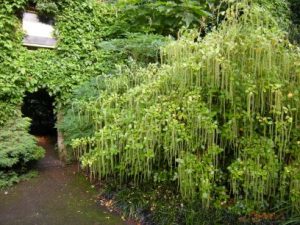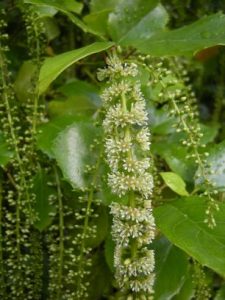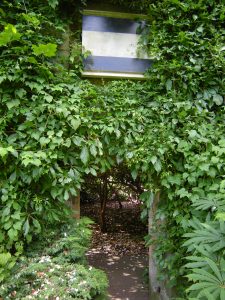Itea ilicifolia an expansive evergreen shrub collected by Ernest Wilson in Hubei Province at the relatively low altitude of 300 – 900 metres. Initially not thought to be hardy, other than in the most favoured parts of the British Isles. Our plant is now 2.5 metres high and at least 4 m wide. Thriving in a south east sheltered corner by Inverleith House. Indeed the glossy leaves with a spiked edge are the picture of health. The leaves resemble those of Holly, but not as thick or leathery.
Flowering profusely from the shoot ends, the individual flowers are held on pendulous racemes many drooping down 350mm in length. These are a green colour in bud, opening white. To the naked eye the colour seems to reflect off the stamens but through a hand lens the 5 or 6 narrow petals are visible, white in colour.
Above the doorway in the wall is the horizontal striped sandstone form by Alan Johnston, Haus Wittgenstein/Inverleith House 1995.
Paul Nesbitt, Curator of Exhibitions at Inverleith House provided the additional information:
Artist: Alan Johnston
Title: ‘Haus Wittgenstein/Inverleith House’, (1995)
Materials: Beeswax, charcoal and varnish on stone
Ownership: On permanent loan from the artist
Made to accompany the award-winning exhibition of the same name held at Inverleith House during the 1995 Edinburgh Festival, this sculpture by the Scottish artist Alan Johnston (b.1945) related directly to two major philosophical figures; Ludwig Wittgenstein (1889-1951) and David Hume (1711-1776). The upper edge of the work incorporates a detail from the circular tomb of David Hume, located in the Calton Burial Ground in Edinburgh, whilst the lower edge refers to the raising of the ceiling (by 3cms) of the House Wittgenstein built in Vienna (1928), where Johnston made an exhibition in counterpart to the one at Inverleith House, during the previous year (1994).




1 Comment
1 Pingback